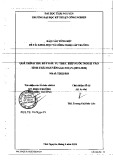
Page 1 of 2
(page number not for citation purposes)
Available online http://ccforum.com/content/11/4/160
Abstract
Tight glycaemic control has emerged as a major focus in critical
care. However, the struggle to repeat, improve and standardize the
results of the initial landmark studies is ongoing. The prospective
computerized glycaemic control study by Shulman et al. highlights
two emerging and often overlooked aspects of intensive insulin
therapy protocols beyond simple glycaemic performance. First, the
clinical ergonomics and ability to integrate into the critical care unit
workflow must be considered as they may impact results and
definitely affect uptake. Second, the real lessons of any protocol’s
performance are likely to be best realized by comparison with other
results, a task that is very difficult without a consensus method of
reporting that allows such comparisons across studies. Embracing
these issues will take the field closer to accepted, repeatable
approaches to tight glycaemic control.
That tight glycaemic control in critical care saves lives is
increasingly less questioned. In contrast, the how and for
whom remains quite elusive. In this journal, Shulman et al. [1]
report the results of another prospective glycaemic control
study utilizing a computerized protocol to implement a
relatively complex protocol.
Tight control has been of great interest since the landmark
studies of Van den Berghe et al. [2,3] and Krinsley [4]. At
least two to three further, large, randomized trials have been
started, including the ongoing Normoglycemia in Intensive
Care Evaluation (NICE)-Survival Using Glucose Algorithm
Regulation (SUGAR) studies [5], and the discontinued
Efficacy of Volume Substitution and Insulin Therapy in
Severe Sepsis (VISEP) study [6]. Finally, several prospective
studies, primarily focused on developing new protocols,
have been published, to the extent that reviews have recently
appeared [7-9].
Two common themes emerge that are also evident in this
study. The first concerns the impact of clinical burden on the
results obtained. The second is one of performance. What
defines good performance, and what level is required to
achieve the mortality and economic [10,11] outcomes of the
landmark studies?
The clinical burden of intensive insulin therapy (IIT) has not
gone unnoticed [12,13]. Shulman and colleagues, have
uniquely addressed this issue directly by tracking compliance
in the timing of glucose measurements and thus perhaps
compliance and performance in control. Only 53%
(interquartile range: 41 to 67%) of glucose measurements
were performed in the specified one to two hour timeframe,
including a 50% (30 to 60 minutes) buffer. This result is
unique in the field and clearly shows for the first time the
difficulty of integrating any protocol into the typically hectic
intensive care unit (ICU) environment.
In contrast, Van den Berghe et al. [2,3] utilized additional staff
to reduce burden and avoid contamination across their ran-
domized trial. The higher average glycaemic control obtained
by Krinsley [4] without such extra staffing thus indicates the
(potential) impact of clinical burden on performance. This
paper thus clearly highlights the little addressed issue of
human factors and the need to consider them explicitly in
protocol design – perhaps including experts in the field – to
obtain more consistent results. More succinctly, it may not be
the protocol but the ability to implement it effectively that
prevents success in some cases.
Regarding performance, patients in this study were in the
target 4.4 to 6.1 mmol/L band, a median of 23.1% (15.4 to
Commentary
Is there more to glycaemic control than meets the eye?
J Geoffrey Chase1and Geoffrey M Shaw2
1Department of Mechanical Engineering, Centre for Bio-Engineering, University of Canterbury, Private Bag 4800, Christchurch, New Zealand
2Department of Intensive Care Medicine, Christchurch Hospital and University of Otago School of Medicine – Christchurch, Private Bag 4710,
Christchurch, New Zealand
Corresponding author: J Geoffrey Chase, geoff.chase@canterbury.ac.nz
Published: 30 August 2007 Critical Care 2007, 11:160 (doi:10.1186/cc6099)
This article is online at http://ccforum.com/content/11/4/160
© 2007 BioMed Central Ltd
See related research by Shulman et al., http://ccforum.com/content/11/4/R75
ICU = intensive care unit; IIT = intensive insulin therapy; NICE-SUGAR = Normoglycemia in Intensive Care Evaluation-Survival Using Glucose Algo-
rithm Regulation [studies]; VISEP = Efficacy of Volume Substitution and Insulin Therapy in Severe Sepsis [study].

Page 2 of 2
(page number not for citation purposes)
Critical Care Vol 11 No 4 Chase and Shaw
29.1%) of the time, with a further 48.5% (36.9 to 60.8%) in
the 6.2 to 7.99 mmol/L band. The authors conclude that the
protocol “did not achieve tight glycaemic control for a
substantial portion of each patient’s stay”. However, their
results are similar in average value and tighter in distribution
than the very successful results of Krinsley [4], based on
values estimated from Figure 2 and Table 4 in Krinsley's
original work [4] and the data presented by Shulman et al.
They are also similar to other studies [14-16].
This contradiction illustrates the almost complete inability to
assess or compare performance consistently across studies.
A review of 24 studies [7] shows that five use percentage
time in a single band, while most others use a mean value and
standard deviation. Target range and measurement frequency
also varied considerably. Combined with differences in cohort
and critical illness, it is very difficult to take significant lessons
away from many of these studies. This is not a fault of the
study authors or implementation, but a lack of a consensus
means of reporting.
Shulman et al., provide significant insight into their results
compared to many others, reporting percentage time in
bands on a per patient basis as well as indicating the varia-
bility across the cohort via the box and whiskers plot of Figure 2.
From this data and Table 4 it is possible to determine both
median and variability on a per patient basis – the same basis
on which tight control has a clinical impact. It is also some-
thing not reported in most similar studies, making this study
unique for its transparency. Variability is particularly important
as a recent study of over 7,000 patients showed that the
glycaemic variability is an independent predictor of mortality
[17], and thus a potentially critical performance measure.
In contrast, almost all studies report glycaemic control in
terms of overall results, rather than per patient. Thus, one
could (in extreme) report relatively wide variability for a
protocol, when in fact each patient was tightly controlled
within that range – or vice versa. Shulman et al.’s complete
and transparent per patient reporting is a stronger template
on which to make comparisons and derive lessons learned.
Thus, a second clear outcome highlighted by this study is the
need for a consensus statement with regard to reporting
glycaemic control performance. A better understanding would
result from specifying a minimum standard that included per
patient and overall results for a series of accepted glycaemic
ranges and thus variability. This call is not necessarily new
[18], but perhaps bears repeating.
More succinctly, a standard method of reporting results
would enable easier comparison across studies and cohorts,
with an ultimate goal of enabling better understanding of
what performance metrics (time in band, variability, etc) are
important. Coupled with improved ergonomics and
integration into typical ICU environments, the potential to
create consistently repeatable results will increase, potentially
substantially. And thus, we might well be able to begin
answering the difficult questions of how and for whom”.
Competing interests
The authors have also published and done research
extensively in the field of IIT protocol design.
References
1. Shulman R, Finney SJ, Greene R, Glynne PA, O’Sullivan C: Tight
glycaemic control: a prospective observational study of a
computerised decision-supported intensive insulin therapy
protocol.Crit Care 2007, 11:R75.
2. Van den Berghe G, Wouters P, Weekers F, Verwaest C, Bruyn-
inckx F, Schetz M, Vlasselaers D, Ferdinande P, Lauwers P, Bouil-
lon R: Intensive insulin therapy in critically ill patients. N Engl J
Med 2001, 345:1359-1367.
3. Van den Berghe G, Wilmer A, Hermans G, Meersseman W,
Wouters PJ, Milants I, Van Wijngaerden E, Bobbaers H, Bouillon
R: Intensive insulin therapy in the medical ICU. N Engl J Med
2006, 354:449-461.
4. Krinsley JS: Effect of an intensive glucose management proto-
col on the mortality of critically ill adult patients. Mayo Clin
Proc 2004, 79:992-1000.
5. McMullin J, Brozek J, McDonald E, Clarke F, Jaeschke R, Heels-
Ansdell D, Leppert R, Foss A, Cook D: Lowering of glucose in criti-
cal care: a randomized pilot trial. J Crit Care 2007, 22:112-118.
6. Brunkhorst F, Kuhnt E, Engel C, MeierHellmann A, Ragaller M,
Quintel M, Weiler N, Gründling M, Oppert M, Deufel T et al.:
Intensive insulin therapy in patient with severe sepsis and
septic shock is associated with an increased rate of hypo-
glycemia – results from a randomized multicenter study
(VISEP). Infection 2005, Suppl 1:19.
7. Meijering S, Corstjens AM, Tulleken JE, Meertens JH, Zijlstra JG,
Ligtenberg JJ: Towards a feasible algorithm for tight glycaemic
control in critically ill patients: a systematic review of the liter-
ature. Crit Care 2006, 10:R19.
8. Wilson M, Weinreb J, Hoo GW: Intensive insulin therapy in crit-
ical care: a review of 12 protocols. Diabetes Care 2007,
30:1005-1011.
9. Schultz MJ, Royakkers AA, Levi M, Moeniralam HS, Spronk PE:
Intensive insulin therapy in intensive care: an example of the
struggle to implement evidence-based medicine. 2006,
3:e456.
10. Van den Berghe G, Wouters PJ, Kesteloot K, Hilleman DE: Analy-
sis of healthcare resource utilization with intensive insulin
therapy in critically ill patients. Crit Care Med 2006, 34:612-616.
11. Krinsley JS, Jones RL: Cost analysis of intensive glycemic
control in critically ill adult patients. Chest 2006, 129:644-650.
12. Aragon D: Evaluation of nursing work effort and perceptions
about blood glucose testing in tight glycemic control. Am J
Crit Care 2006, 15:370-377.
13. Mackenzie I, Ingle S, Zaidi S, Buczaski S: Tight glycaemic
control: a survey of intensive care practice in large English
hospitals. Intensive Care Med 2005, 31:1136.
14. Goldberg PA, Sakharova OV, Barrett PW, Falko LN, Roussel MG,
Bak L, Blake-Holmes D, Marieb NJ, Inzucchi SE: Improving
glycemic control in the cardiothoracic intensive care unit: clin-
ical experience in two hospital settings. J Cardiothorac Vasc
Anesth 2004, 18:690-697.
15. Goldberg PA, Siegel MD, Sherwin RS, Halickman JI, Lee M,
Bailey VA, Lee SL, Dziura JD, Inzucchi SE: Implementation of a
safe and effective insulin infusion protocol in a medical inten-
sive care unit. Diabetes Care 2004, 27:461-467.
16. Zimmerman CR, Mlynarek ME, Jordan JA, Rajda CA, Horst HM:
An insulin infusion protocol in critically ill cardiothoracic
surgery patients. Ann Pharmacother 2004, 38:1123-1129.
17. Egi M, Bellomo R, Stachowski E, French CJ, Hart G: Variability of
blood glucose concentration and short-term mortality in criti-
cally ill patients. Anesthesiology 2006, 105:244-252.
18. Gale SC, Gracias VH: Glycemic control needs a standard ref-
erence point. Crit Care Med 2006, 34:1856-1857.



![Báo cáo seminar chuyên ngành Công nghệ hóa học và thực phẩm [Mới nhất]](https://cdn.tailieu.vn/images/document/thumbnail/2025/20250711/hienkelvinzoi@gmail.com/135x160/47051752458701.jpg)






















